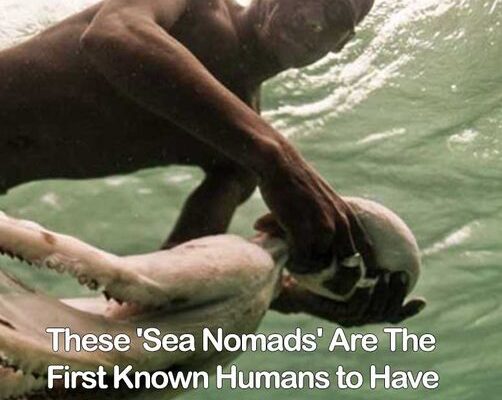I pride myself as a blue mind who loves the water with a strange obsession. Sadly, I can’t hold my breath underwater for up to a minute. The average healthy person who isn’t trained in static apnea can hold their breath for a maximum of two minutes underwater, with the added benefit of breathing in pure oxygen beforehand.
Now imagine a tribe of people, an ethnicity that is genetically adapted to survive underwater without oxygen for at least 13 minutes on an average. The Bajau Laut people of Southeast Asia are not specially trained in modern static apnea, but they’ve been discovered to have evolved physiologically and genetically, gaining new features that have basically turned them to human seals [1].
The diving reflex is a group of automatic responses that occur when the face of an air-breathing mammal is submerged into water. Your blood vessels constrict, your spleen contracts, and your heart rate slows in response to being low on oxygen. Your body will try to maximize its oxygen reserves until you can breathe in oxygen again. The splenic contraction is especially important as it releases red blood cells and increases the oxygen capacity of the blood.
Sea Gypsies
The Bajau people are a seafaring, nomadic, fishing clan who spend almost 60 percent of their life deep-diving underwater. A 2018 study published in the Journal Cell found that they may have evolved to have larger spleens, estimably 50 percent bigger than that of an average person [2]. This enables them to maintain the diving reflex for much longer while underwater. An enlarged spleen would mean a more sufficient red blood cell reservoir for deep-diving purposes. More red blood cells would mean that you would be able to carry more oxygen in your blood, allowing for longer dives. Essentially improving how efficient we are at utilizing the oxygen we breathe in.
The Bajau are subsistent people found in the waters off Indonesia, Malaysia, and the Philippines, living in long houseboats known as lepas. They fish for their food and only come to the town to trade for other items or to seek shelter from storms. The Bajau have lived on the sea for many centuries and about 200 years ago, some populations began to settle on the shores, especially in and on the coasts of Malaysia [3].
They have several traditional methods of fishing, with diving being the most common. Using wooden goggles and hand weights, they swim as deep as 30 meters (100 feet) into the water to catch fish for survival. They also love to dive for a particular sea cucumber species known as trepang, with which local delicacies and soups are made.
The researchers found that members of the tribe who do not dive also have the genetic mutation of an enlarged spleen. They suspect that a particular gene known as PDE10A might be responsible for the mutation in the Bajau. PDE10A controls a thyroid hormone known as T4 which increases metabolic rates and combats low oxygen levels in times of distress. T4 has been linked to larger spleen sizes in mice. Also, mice that have been manipulated to have lower amounts of T4 would end up with smaller spleens.
“If there’s something going on at the genetic level, you should have a certain sized spleen. There we saw this hugely significant difference,” said Melissa Ilardo, lead scientist in the research at National Geographic.
There were other diving-specialized genes specialized discovered in the Bajau, performing several functions that wouldn’t be found even in people of other ethnicities close to the Bajau. When the diving response kicks in, one of these genes would cause blood to rush from the limbs and other non-essential parts to the heart and lungs. Another would prevent the occurrence of hypercapnia from extended periods spent underwater, a condition caused by elevated levels of carbon dioxide in the blood.
Other adaptations
There is another physiological adaptation suspected to be at play in the Bajau people. Richard Moon, a scientist from the Duke University School of medicine studies the body’s reaction to extreme depths and high altitudes. Deep diving causes blood to fill the vessels in the lungs and if they are ruptured, the victim could die in a matter of minutes. Moon believes that regular training and constant diving could cause the walls of the lungs to become stronger and more adapted to withstand high volumes of blood.
“The lung chest wall could become more compliant. There could be some looseness that develops over your training. The diaphragm could become stretched. The abs could become more compliant. We don’t really know if those things occur,” he said to National Geographic [4]. “The spleen is able to contract to some extent, but we don’t know of any direct connection between thyroid and spleen.”
This adaptation is found to be common in the Tibetans and the Bajau. The Tibetans live on the lofty plateaus in the Himalayas, a place called the “Roof of the World” because of its stunningly high altitudes. To live at such heights, the Tibetans also have some peculiar physical adaptations.
The future of hypoxia
Although they are countries away from each other, the researchers believe that the Tibetans and the Bajau may have suffered extensively from hypoxia in older generations. Hypoxia is a condition characterized by a deficiency of oxygen in the tissues to sustain bodily functions [5]. It is possible that the ancient members of these two ethnicities suffered so greatly from hypoxia that their genes mutated to enable them to cope with it. Modern-day Tibetans can now survive better at high altitudes and the Bajau can dive to extreme depths underwater.
There is hope for new knowledge on hypoxia management techniques from studying these clans, especially the Bajau.
According to Ilardo, marginalization, and segregation is making life exceptionally difficult for the Bajau in their native dwellings. They are not regarded as equals with the citizens of the countries in which they make their homes on seas and shores. Thousands of them have migrated from the seas due to increased industrial fishing by their host countries. She fears that they may be fully dispersed by the time scientists are ready to delve into researching their adaptations.




